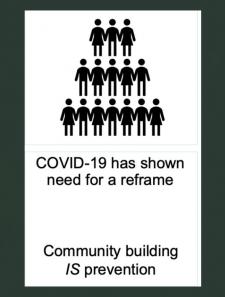The pandemic is not the problem; we have an identity problem in domestic violence prevention

"One of the most common questions from preventionists at the onset of the coronavirus pandemic was 'How do we keep doing prevention during a pandemic?' Regular phone calls were scheduled to brainstorm approaches and the general feeling in the room was panic. I get it. I understand that when your prevention work is mainly reliant on in-person programming in settings such as schools and youth centers, having to figure out how to “do a prevention program” some other way is difficult and stressful. There also is the omnipresent pressure to fulfill grant obligations and meet project timelines, sometimes without regard or mention of community context or need.
I would like to suggest that asking how to continue a prevention program in the midst of a worldwide pandemic actually is a red flag that your prevention programming may not be as inclusive or community-centered as it needs to be. Put more bluntly, the question about implementing 'prevention programs' implies that prevention is separate from upholding the health and wellness of our communities, which is tied to the 'either/or thinking' characteristic of white supremacy culture."

